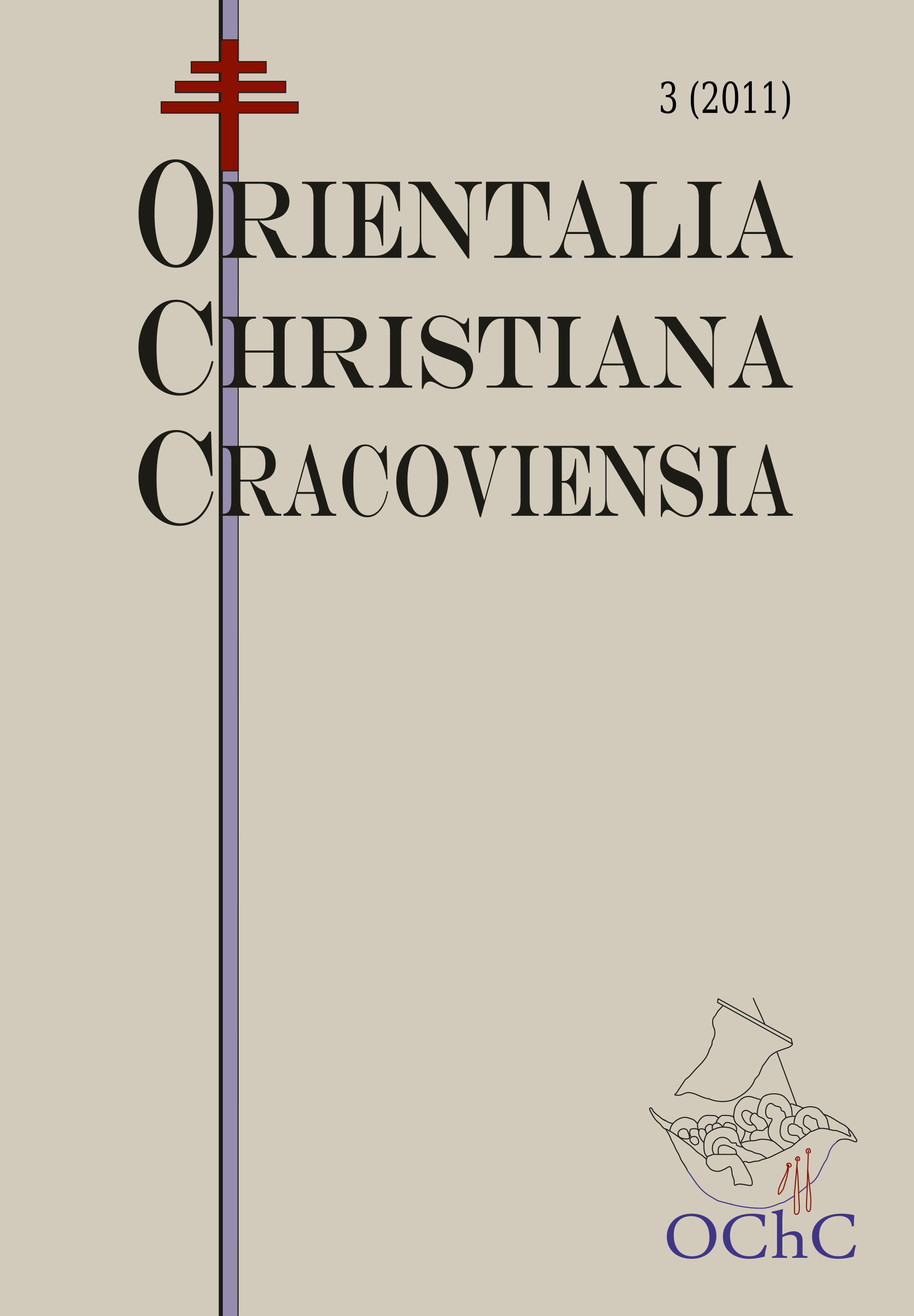Jewish and Christian religious influences on pre-Islamic Arabia on the example of the term RḤMNN (“the Merciful”)
DOI:
https://doi.org/10.15633/ochc.1024Słowa kluczowe:
Inscriptions, RḤMNN, South Arabia, Arabs, Jews, ChristiansAbstrakt
The well known epithet, RḤMNN is constantly confirmed in inscriptions particularly from so-called “Late Sabaean Period” (after 380) which were associated with monotheism. In this time Judaism and Christianity attempted to replace the traditional South Arabian religion. In this context RḤMNN was used by polytheists Arabs, Jews and Christians.
Bibliografia
Beeston A. F. L., Notes On The Mureighan Inscription, “Bulletin of The School of Oriental and African Studies” 16 (1954), pp. 391–392.
Beeston A. F. L., The Religions of Pre-Islamic Yemen, in : J. Chelhod (Ed.), L’Arabie du Sud. Histoire et Civilisation, vol. I : Le peuple Yemenite et ses racines), Paris 1984, pp. 267–268.
Beeston A. F. L., Two Bi’r Ḥimā Inscriptions Re-Examined, “Bulletin of the School of Oriental and African Studies” 48 (1985) no. 1, p. 42–52.
Brunner U., The Great Dam and the Sabean Oasis of Marib, “Irrigation and Drainage Systems” 14 (2000), p. 167–182.
Corpus inscriptionum semiticarum ab Academia Inscriptionum et Litterarum Humaniorum Conditum atque Digestum, Pars Quarta: Inscriptiones Himyariticas et Sabæas continens, Tomus 2, Parisiis 1911.
Greenfield J. C., From ‘LH RḤMN To AL-RAḤMĀN: The Source Of A Divine Epithet”, in: B. H. Hary, J. L. Hayes & F. Astren (eds.), Judaism And Islam: Boundaries, Communication And Interaction – Essays In Honor Of William M. Brinner, Leiden 2000.
Greenfield J. C., Aspects of Aramean Religions, in: M. Shalom, S. Paul, M. E. Stone, A. Pinnick (eds.), Al kanfei Yonah: collected studies of Jonas C. Greenfield on Semitic Philology, Jerusalem 2001.
Healey J. F., The Religion of the Nabataeans: A Conspectus, Leiden 2001 (Religions in the Graeco-Roman World, 136).
Hawting G., The Idea of Idolatry and the Emergence of Islam, Cambridge 1999.
Hirschfeld H., New Researches into the Composition and Exegesis of the Qoran, London 1902.
Hitti P., History of the Arabs : from the earliest times to the present, Basingstoke 2002.
Jeffery A., The Foreign Vocabulary of the Qur’ān, Baroda 1938.
Jomier J., Le nom divine al-Raḥmān in Coran, in: Mélange Louis Massignon, vol. 2, Damascus 1957.
Kitchen K. A., Documentation for Ancient Arabia, Part I: Chronological Framework and Historical Sources, Liverpool 1994 (The World of Ancient Arabia Series).
Kościelniak K., XX wieków chrześcijaństwa w kulturze arabskiej, vol. 1, Kraków 2000.
Kościelniak K., Chrześcijańskie piśmiennictwo arabskie przed Mahometem i jego wpływ na islam, “Analecta Cracoviensia” 35 (2003), pp. 329–343.
Kościelniak K., Quelques remarques sur la littérarure pré-islamique arabe chrétienne, “Rocznik Orientalistyczny” 57 (2004), pp. 69–76.
Kościelniak K., From Grecian to Arabic. The Contribution of the Melchite Church to Arabic Culture in the early Middle Ages (VIIth–XIth Centuries), “Analecta Cracovienisa” 12 (2006–2007), p. 483–495.
Munro-Hay S. C., Aksum: An African Civilization of Late Antiquity, Edinburgh 1991.
Ryckmans G., Inscriptions Sud-Arabes – Dixième Série, Le Muséon” 66 (1953).
Ryckmans J., The Old South Arabian Religion, in W. Daum (Ed.), Yemen: 3000 Years of Art and Civilisation in Arabia Felix, Innsbruck 1988.
Saifullah M. S. M., David A., Raḥmānān (RḤMNN) – An Ancient South Arabian Moon God?, http://www.islamic-awareness.org/Quran/Sources/Allah/rhmnn.html, quoted: 20.03.2011.
Sima A., Religion, in: St. J. Simpson (Ed.), Queen of Sheba: Treasures from Ancient Yemen, London 2002, p. 165.
Smith S., Events in Arabia in the 6th Century, “Bulletin of the School of Oriental and African Studies” 16 (1954), p. 425–468.
Tregelles S. P. (transl.), Gesenius’s Hebrew and Chaldee Lexicon to the Old Testament Scripture: translated with additions and corrections from the Author’s Thesaurus and other Works, London 1881.
Vargo A., Responses to Islamic Awareness: Rahmanan (RHMNN) – An Ancient South Arabian Moon God?, http://www.answering-islam.org/Responses/Saifullah/rahman_av.htm.
Vogt B., Der Grosse Damm von Marib – Neue Forschungen des Deutschen Archäologischen Instituts 2002, “Hefte zur Kulturgeschichte des Jemen” 1 (2003), p. 75–85.
Vogt B., Towards a new dating of the great dam of Marib. Preliminary results of the 2002 fieldwork of the German Institute of Archeology, “Proceedings of the Seminar for Arabian Studies” 34 (2004), p. 383–394.
Zwettler M. J., Ma’add In Late-Ancient Arabian Epigraphy And Other Pre-Islamic Sources, “Wiener Zeitschrift Für Die Kunde Des Morgenlandes” 90 (2000), p. 223–309.
Pobrania
Opublikowane
Numer
Dział
Licencja
Twórca oświadcza, że przysługują mu prawa autorskie do utworu i że nie są ograniczone w zakresie objętym niniejszym oświadczeniem oraz że utwór jest dziełem oryginalnym i nie narusza praw autorskich innych osób.
Twórca zezwala Uniwersytetowi Papieskiemu Jana Pawła II w Krakowie na nieodpłatne, niewyłączne i nieograniczone w czasie korzystanie z utworu, to jest:
- utrwalanie i zwielokrotnianie: wytwarzanie egzemplarzy utworu techniką drukarską, reprograficzną, zapisu magnetycznego oraz techniką cyfrową;
- obrotu oryginałem albo egzemplarzami, na których utwór utrwalono (wprowadzanie do obrotu, użyczenie lub najem oryginału albo egzemplarzy, publiczne wystawienie, wyświetlenie, a także publiczne udostępnianie utworu w taki sposób, aby każdy mógł mieć do niego dostęp w miejscu i w czasie przez siebie wybranym);
- włączenie utworu w skład utworu zbiorowego;
- udzielanie przez Uniwersytet Papieski Jana Pawła II w Krakowie sublicencji Creative Commons Uznanie autorstwa-Użycie niekomercyjne-Bez utworów zależnych 3.0 Polska
Uniwersytet Papieski Jana Pawła II w Krakowie udostępnia utwór na Platformie Czasopism należącej do uczelni, na licencji Creative Commons Uznanie autorstwa-Użycie niekomercyjne-Bez utworów zależnych 3.0 Polska. Tym samym uprawnia wszystkich zainteresowanych do korzystania z utworu pod następującymi warunkami:
- zostanie podany autor i tytuł utworu,
- zostanie podane miejsce publikacji (tytuł czasopisma i adres internetowy do oryginalnie opublikowanego utworu),
- utwór będzie dystrybuowany w sposób niekomercyjny,
- nie będą tworzone utwory zależne.

